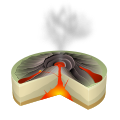1868 Hawaii earthquake
The earthquake occurred at 4 p.m. local time on April 2, 1868, and caused a landslide and tsunami that led to 77 deaths.
Continued growth of the southeastern part of the island is accompanied by major slumping and southeastward movement of the flanks of the two volcanoes.
From the interpretation of seismic reflection data, it has been proposed that the southeastward displacement takes place on a decollement surface near the top of the oceanic crust.
The 'backscarp' to the slump is formed by the Hilina extensional fault system, which is known to have moved in both the 1868 event and the 1975 Kalapana earthquake.
[3] One interpretation of this sequence of events is that they were related to the movement of two separate landslide structures on the south side of the island.
The first, triggered by an eruption that began in the upper part of Mauna Loa's southwest rift, involved movement of a block that extended seawards for at least 12 miles (19 km).
The mainshock involved movement of the entire southern flank of Kīlauea on the basal detachment at an estimated depth of 9 kilometers (5.6 mi),[9] and was probably triggered by the earlier event.


